Continental Currency
November 2, 1776
An emission totaling $5,000,000 payable in Spanish milled dollars, or the equivalent in gold or silver, was authorized by the Continental Congress resolutions of November 2nd and December 28th, 1776. The issue is similar to that of July 22, 1776. Printed by Hall and Sellers in Philadelphia. The paper, made at Ivy Mills in Chester County, Pennsylvania, contained blue fibers and mica flakes. Detector bills were printed on blue paper. Denominations include the: $2, $3, $4, $5, $6, $7, $8 and $30.obv
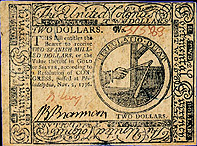
$2 Serial Number: 31,583 CC 11/02/76
Signers: Benjamin Levy (in red), Benjamin Brannan.
Size: not available
Comments: The numbering and first signature are in red ink; second signature is in black ink. The emblem on the front shows grain being threshed with a flail with the motto: "Tribulatio ditat" (It is enriched by affliction). The nature print on the back is of a rasberry and two filbert leaves and is identical to a nature print used on earlier Pennsylvania currency. No image of the back is available. The paper contains blue threads and mica flakes.
Courtesy of Early American Numismatic Auctions, Inc. Images used with permission from their on-line auction catalog for the auction of April 20, 1996, lot 369.
obv
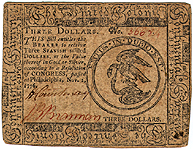 rev
rev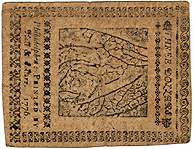
$3 Serial Number: 36,684 CC 11/02/76.
Signers: Hercules Courtenay, Benjamin Brannan (sometimes Brannon).
Size: 72 x 92mm (front border design: 70 x 92mm; back border design: 67 x 88mm).
Comments: The first signature is in brown ink; numbering and second signature are in red ink. The emblem on the front (40mm) depicts an eagle fighting a heron with the motto "Exitus in dubio est" (The outcome is in doubt). On the back is a nature print of skeletonized elm and maple fruit. The paper contains blue thread and mica flakes.
Provenance: Purchased through the Robert H. Gore, Jr. Numismatic Endowment from the collection of William Warne of Harvey Cedars, NJ on 5/1/98.
Another example of the $3 note from the collection of William Warne of Harvey Cedars, NJ. Serial number 3085, signed by James Walker and Horatio Johnson click here for the front and then here for the back
 rev
rev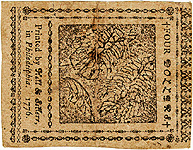
$4 Serial Number: 21,835 CC 11/02/76
Signers: Robert Dorsey, Thomas Donnellan.
Size: 75 x 95mm (front border design: 71 x 92.5mm; back border design: 68 x 90mm).
Comments: The numbering and second signature are in red ink; the first signature is in brown ink. The emblem on the front shows a wild boar charging into a spear with the motto: "Aut mors aut vita decora" (Either death or an honorable life). The nature print on the back is of skeletonized maple fruit and is identical to a nature print used on earlier Pennsylvania currency. The paper contains blue threads and mica flakes.
Provenance: Purchased through the Robert H. Gore, Jr. Numismatic Endowment from the EANA mail bid auction 11/16/96, lot 484.
obv
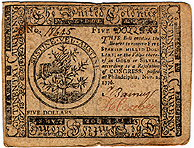 rev
rev
$5 Serial Number: 18,645 CC 11/02/76.
Signers: Joshua Barney, Hans Creevey (sometimes Crerry).
Size: 77 x 100mm (front border design: 70 x 92mm; back border design: 68 x 88mm).
Comments: The numbering and first signature are in brown ink; the second signature is in red ink. The emblem on the front (39mm) shows a bleeding hand in a thorn bush with the motto: SUSTINE VEL ABSTINE. The B is an H modified to from a letter B. This is the most difficult emblem in the series to understand. Benjamin Franklin explained the Continental Currency emblems in a letter published under the pseudonym of Clericus in the Pennsylvania Gazette of September 20, 1775. For the five dollar emblem he explained:
...we have a thorny bush, which a hand seems attempting to eradicate. The hand appears to bleed, as pricked by spines. The motto is, SUSTINE VEL ABSTINE; which may be rendered, Bear with me, or let me alone; or thus, Either support or leave me. The bush I suppose to mean America, the bleeding hand Britain. Would to God that bleeding were stopt, the wounds of that hand healed, and its future operations directed by wisdom and equity; so shall the hawthorn flourish, and form an hedge around it, annoying with her thorns only its invading enemies. [B. Franklin, Writings, ed. by J.A. Leo Lemay, 1987, pp. 734-738 on p. 735.]The nature print on the back is of betony and sage. The paper contains blue threads and mica flakes.
Provenance: Purchased through the Robert H. Gore, Jr. Numismatic Endowment from the collection of William Warne of Harvey Cedars, NJ on 5/1/98.